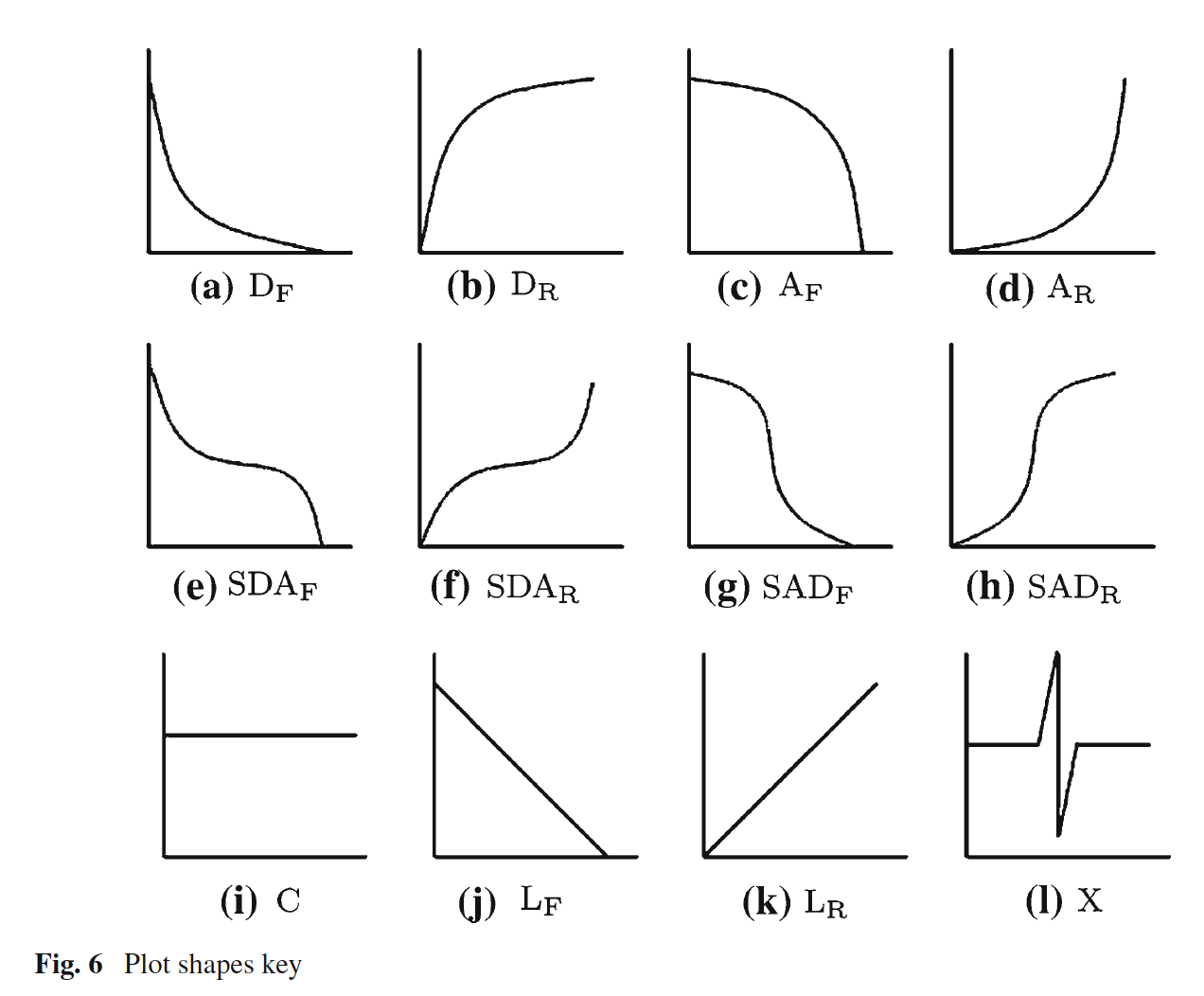
Understanding Clusters - Range and Shape Keys in Measure of Concordance
June 21, 2019
A paradigm apparatus for the evaluation of clustering comparison techniques and distinguish between the goodness of clusterings and the similarity of clusterings by clarifying the degree to which different measures confuse the two. Accompanying this is the proposal of a novel clustering similarity measure, the Measure of Concordance (MoC).
Range and shape key Following is a short summary of of the different graphical shapes and descriptor labels used to characterise a measure’s general behaviour for each given test.
- Constant functions are indicated by the symbol C.
- Linear functions are indicated by the symbol L, with a subscript of either F or R to indicate whether their value respectively falls or rises over the interval.
- Non-linear functions are described in terms of whether the absolute value of their derivative over the interval is increasing or decreasing, i.e. whether the function value is accelerating or decelerating. Decelerating functions are indicated by the symbol D, and accelerating functions by the letter A, with subscripts F and R indicating falling and rising behaviour as before.
- Sigmoid functions can be described as piecewise functions assembled from a pair of falling or a pair of rising functions, with the two members of the pair exhibiting opposite accelerating/decelerating behaviour. So for instance, the shape labelled as SADF in Fig. 6g is constructed from an initial AF function followed by a DF function. The other three sigmoid functions are defined similarly.
- Functions which are undefined over the interval are indicated by a U.
- Other functions are indicated by an X, however there is only one such function (Forbes in the Incremental Independence test.)
Source: Pfitzner, D., Leibbrandt, R. & Powers, D. Knowl Inf Syst (2009) 19 361. https://doi.org/10.1007/s10115-008-0150-6
Source URL: https://link.springer.com/article/10.1007/s10115-008-0150-6
ID: understanding-clusters-range-and-shape-keys-in-measure-of-concordance
Categories:
Tags: Boerhaave | COGWEB | Chinese | LSTM | Leiden | PGM | RNN | Ruysch | actors | aesthesis | agency | algorithm | analysis | anatomical | anatomy | androgynous | architecture | archive | artificialia | axis | black-box | body | botanical | brain | categories | categorization | channel | character recognition | chinese | classification | clustering | cnn | codes | cognition | collecting | collection | collections | colonialism | commodification | concept | conceptual-clustering | convolutional neural network | cost | counting | cut | cuts | cutting | datasets | demonstration | diagram | dimensionality | disgust | dissection | distance | domestication | elegance | epistemology | error | euclidean | evaluation | eye | figures | finger | forecasting | forensics | frame | freakish | geometry | gesture | gestures | gradient descent | graph | graphs | grouping | hacking | hand | hand writing | hands | hands-on | handwriting | hardware | history | human | human body | imagination | imperfect | inscription | instruments | joint | kmeans | knowledge | labeling | landmark | learning | location | machine learning | machines | materiality | meaning | measurement | memory | mnist | model | models | monsters | muscles | mystical | mythological | naturalia | nerves | nervous system | network | networks | neural networks | neural-anatomy | neuron | nonlinearity | observation | offline | online | ontologies | ontology | ontology-building | optimization | orientation | orthogonality | parallel | pca | perception | perceptron | perfection | performance | planes | poetic | position | prediction | preparation | preparations | projection | proportion | proportions | psychology | python | races | representation | representations | rhetoric | rnn | segments | selection | sensory experience | sensory perception | similarity | skeleton | skin | skull | skulls | space | sparseness | spectacle | spectators | speech | standard | statistic-ontology | statistical | statistical-ontology | svm | symbols | tacit | taxonomy | theatre | time-series | timeseries | tools | topological | training | treatise | trial | truth | type | typography | unsupervised | vision | visualization | wellcome | word2vec | writing | zodiac |